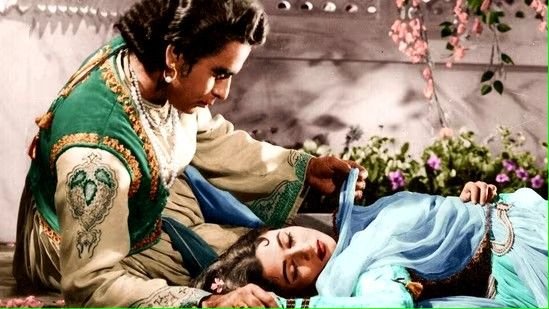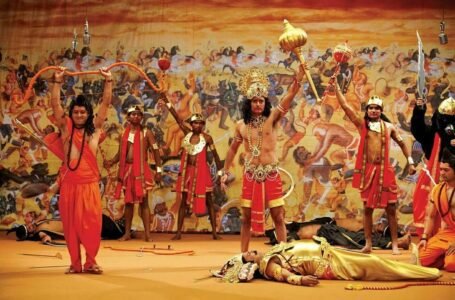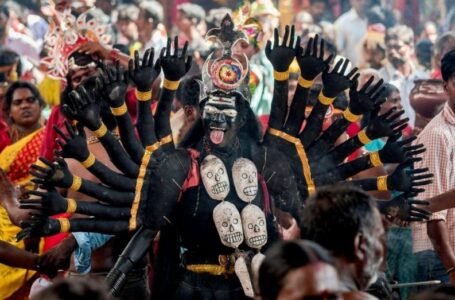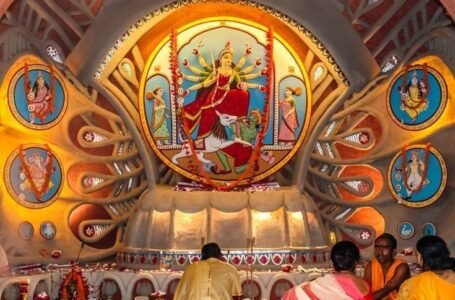Costumes, Crowns, and Cinematic Grandeur: Historical Accuracy in Period Films

→ Evaluate how accurate films like Mughal-e-Azam, Troy, Jodhaa Akbar, Lincoln, or Padmaavat were in portraying history
-Anushka Sengupta
Period films are not just stories about a time in the past–they are artistic reconstructions of history where exemplary costumes, elevated crowns, spectacular sets and phenomenal actors do their best to perform characters from the past. Since period films can exert so much cultural power in constructing the popular social understanding of history, we need to ask a key question: how real is reality in period films?
With filmmakers, the balance is difficult to strike between historical fidelity and cinematic kick. According to filmmakers, very often in constructing such a world, the idea is to be immersive and to make the world feel born of emotions rather than of documentation. This essay analyses the historical fidelity of five landmarks in the canon of historical films: Mughal-e-Azam (1960), Troy (2004), Jodhaa Akbar (2008), Lincoln (2012) and Padmaavat (2018), spotlighting how costumes, character construction, political narratives and mise-en-scène either accurately convey or misrepresent historical reality.
Mughal-e-Azam (1960): Cinematic Grandeur in Indian History Films
K. Asif’s Mughal-e-Azam is a seminal epic in Indian cinema that set expectations for how we should imagine the Mughal era. The movie tells the story of the illicit romance between Prince Salim and the court dancer Anarkali, with Emperor Akbar torn between paternal love and imperial duty. The costumes are exquisitely costumed, with hand-embroidered robes, pearl studded-turbans, silk dupattas and heavy Mughal jewelry. Costume Designer Makhanlal & Company worked closely with historians to achieve historically accurate fashions, particularly for Akbar and Salim who wore authentic jama, pagdi and kamarband. The film’s Indo-Persian set design, marble arches, jharokhas and intricate thrones, added up to a visual lexicon that has since become synonymous for the Mughal era. But, Mughal-e-Azam is inspired by Imtiaz Ali’s Taj’s play “Anarkali” (1922), to the extent that it certainly does not rely on historical writings. Nothing glued down in black and white, nothing beyond a line in the legends of the empire. There is no mention of such a romance or the rebellion in Jahangir’s autobiography Tuzuk-i-Jahangiri. In addition, Akbar’s image of as a secular but patriarchal ruler is closer to Nehruvian secularism than the nuanced religious politics of the Mughal court itself. Consequently, while the aesthetic elements are grounded in history, the story is mythologized in nature.
Troy (2004): Epic Myth Reconfigured as Historical Drama
This film is an adaptation of Homer’s The Iliad by Wolfgang Petersen centering around the Trojan War and the ultimate fall of Troy. The original epic is full of divine interventions and figurative layers of meaning but the film aims for a “realist” reimagining. The costumes designed by Bob Ringwood were inspired after researching into Mycenaean Greece and Hittite Anatolia. With attention to material authenticity, characters wear tunics, bronze armour, leather cuirasses and sandals. Armaments and siege engines such as battering rams and towers are convincingly ancient, if not always authentic. Set design in Malta and Mexico employed Cyclopean masonry to recreate the mythic splendour of Troy which blurred the real archaeological traces of Hisarlik (Turkey) and Knossos (Crete). If the events behind the Trojan War really happened, they probably took around 1200 BCE. But the film draws on material from throughout Greek history, squishing together timelines and refusing to concern itself with historical context: Achilles (Brad Pitt) is killed prior to the arrival of the Trojan Horse, which is not true in classical sources where he dies earlier. The gods are entirely absent in the film, and the myth is denuded of its cosmological essence. Paris is depicted as morally confused whereas in Homer’s The Iliad, he is cowardly and ineffectual. The movie attempts to historicize myth but arrives at a hybrid that suits cinematic drama more than academic rigor.
Jodhaa Akbar (2008): A Representation of Secular Romance or Alternative History?
Jodhaa Akbar by Ashutosh Gowariker tries to show political marriage and eventual love between Akbar and one of the Rajput princesses – mostly known as “Jodhaa Bai”. The film mingles diplomacy, war, and romance in a Mughal-Rajput setting. Neeta Lulla’s costumes, which won her a National Award, are luxurious and meticulously researched: Rajasthani lehengas, Mughal angarkhas, maang tikkas and kamarbandhs. The sets resemble Agra Fort, Amber Palace and darbars of the times, with incredible attention to architectural forms characteristic of Indo-Islamic tradition. Combat scenes include historically-based elements including elephant corps, cavalry and other archery formations. The film employs Urdu- inflected Hindi speeches to provide linguistic flavor, although some academicians believe that Persian would have been more authentic at the Mughal court. The most troubling controversy regarding the film is the identity of “Jodhaa Bai.” Notably, many historians appear to dismiss the name as fictional as Akbar’s Hindu wife, Jahangir’s mother was known as Mariam-uz-Zamani (1570-1607) and there is little evidence she would have referred to Jodhaa in her lifetime. The film presents Akbar’s almost-messianic role of religious tolerance in its absolute modern Indian secular ideal, not the political alliances which had to be constructed in 16th century. Though Akbar did initiate the idea of Sulh-i-Kul (universal peace), he probably had both political strategy as well as philosophy in mind.
Lincoln (2012): A Unique Example of Historical Accuracy
Steven Spielberg’s Lincoln, based on Doris Kearns Goodwin’s Team of Rivals, highlights the closing months of Abraham Lincoln‘s life and his efforts to push through the 13th Amendment which would abolish slavery. The film’s production team worked with historians and curators from the Library of Congress and National Archives. The production team brought realistic elements to Daniel Day-Lewis’ performance through primary source research, covering everything, including Lincoln‘s distinctively high-pitched voice, awkward stride and frontier accent. The film’s costumes, including the frock coats, cravats, bonnets and military uniforms draw inspiration from American fashion in the 1860s, using authentic fabric and buttons. The political spaces, including Congress, the White House, and the street protests, are painstakingly reconstructed with care and attention to detail. From other period dramas, Lincoln distinguishes itself as it does not fabricate romance and side-storylines for storytelling. It places the viewer in the legal and ethical debates of abolition-era politics. Different segments of private conversations may be fictionalized, but the first-hand accounts of major speeches and parliamentary debates are sourced from actual transcripts. In this regard, Lincoln is especially distinguished as using the medium of cinema as a means of historical education rather than simple entertainment.
Padmaavat (2018): When Fiction Transforms into Historical Memory
The film Padmaavat is instructively based on Malik Muhammad Jayasī’s 1540 poem Padmavat, which is a Sufi work in the tradition of fantastical literary representation. The narrative is centered around Alauddin Khilji’s obsession with the beauty of Mewar’s queen, Padmavati and her eventual act of jauhar. All aspects of the film serve to support the individual attributes of stylized beauty. Deepika Padukone’s Padmavati is outfitted using Rajasthani poshaks, along with uncut diamond jewelry, ghoomar-style lehengas and gold-plated accessories. Ranveer Singh’s Khilji displays fur-lined cloaks, leather armor and warrior boots, all evoking a vision of fantasy rather than history. The sets for Chittorgarh and Khilji’s court in Delhi are exaggerated representations, staged more for visual spectacle than archaeological relevance. No contemporary writer accounts for Padmavati or jauhar as a memorable moment associated with Padmavati in relation to Alauddin Khilji. Jayasi’s poem is allegorical fantasy, not a historical text. In spite of that, Padmaavat treats this story as national heritage and frames Padmavati’s story as a valiant Hindu historical heroic resistance to Islamic invasion. Khilji’s portrayal in the film as a barbaric, lustful invader complements contemporary levels of communal anxiety, where many scholars have condemned the film as being Islamophobic. Here, cinema becomes not just inaccurate, but also politically charged.
Conclusion: Artifice or Archive?
Period films are often issue driven: they want to tell a good story but also reflect historical truthfulness. Films like Lincoln provide an example of accuracy, as both drama and record. Others, including Padmaavat or Mughal-e-Azam, make romantic, legendary and contemporary ideological points at the expense of historical accuracy and become examples of archived artifice. Costumes and crowns appear as artefacts not of the past, but of how the society chooses to remember the past. Wealthy images ultimately do not mean much if we simply accept we are not watching history, we are watching a version of it, with producers shaping and editing it according to their political obligations, assumptions about viewers’ expectations and prerogatives as creative facilitators. Audiences should be proactive, objecting to modification and acknowledging historical imagination. Period films should not replace academic history, however, when they have integrity they can become portals to academic inquiry and if nothing else, moving examples of what history feels like, if not entirely what it was.


